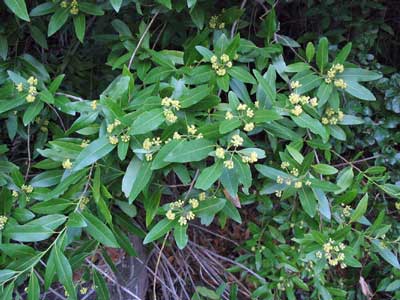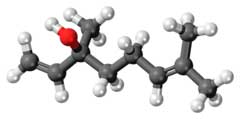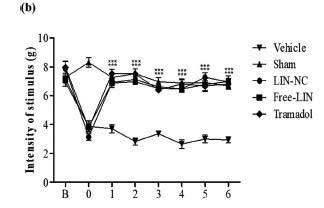This is the second in a series of short blogs on possible future treatments for fibromyalgia.
The smell of mint is uplifting, basil is stimulating, and lavender is known for its calming properties. What do all these plants have in common? They all come from the Lamiaceae or mint family – and they, as well as black tea and citrus fruits, all feature a substance with the whacky name of linalool.
In fact, over two hundred plants contain appreciable amounts of linalool. If you’ve ever smelled the pungent scent of fresh bay leaves from California Bay Laurel (also referred to as pepperwood, spicebush, cinnamon bush, peppernut tree, headache tree, mountain laurel, and balm of heaven (!) ), you’ve been inhaling linalool. The cinnamon on your cinnamon toast contains it.
Plants with this substance have been used through the ages to support health. Bay Laurel tree (Umbellularia californica) were used to treat rheumatism and neuralgias. Tea leaves treated stomach aches, colds and sore throats. They treated headaches by placing a single leaf in the nostril. It is powerful stuff.
Cannabis is another linalool-containing plant. Besides THC and CBD, Cannabis contains one hundred and eighteen other phytocannabinoids and 700 other chemicals (!). Of these, about 50 are present in significant amounts, and linalool is one of them. Some Cannabis users claim linalool strains such as Bubba Kush have calming, anxiety-reducing, sleep and possibly-immune enhancing effects.
Linalool has been reported in the scientific literature to have anticonvulsant, anti-inflammatory, antidepressant, antioxidant, antibacterial, antimicrobial, neuroprotective and even anti-tumor effects. It also may have anti-hyperalgesic effects: i.e. it be able to reduce pain – and that brings us to fibromyalgia (FM).
A 2014 Brazilian study, “Linalool and linalool complexed in β-cyclodextrin produce anti-hyperalgesic activity and increase Fos protein expression in animal model for fibromyalgia“, found that a linalool complex was perking up the descending inhibitory pain pathways that are inhibited in FM. (The ascending pain stimulating pathways are upregulated, and the descending downregulated pain pathways are inhibited in FM.)
Other studies suggest that plants like lavender and rosemary both (high in linalool) may be exerting their calming effects through the modulation of T-type calcium channels (TTCCs) involved in neuronal excitability, neuroprotection, sensory processes and sleep.
That’s all good stuff – but there’s a problem. Linalool (and other monoterpenes) are highly volatile (escape into the air quickly), are not very soluble in water, and, worst of all, have low bioavailability; i.e. it takes large quantities of them to have an effect.
There’s a possible fix though – embed the linalool in nanoparticles called polymeric nanocapsules – and you should be able to increase their stability and bioavailability. These nanocapsules contain an oil-filled cavity circled by a narrow polymeric envelope.
We saw in the intranasal blog that nanoparticles are also being used to package intranasal compounds. They’re basically a more sophisticated drug delivery system which promises to expand the treatment options available and deliver more effective treatments as well.
(-)-linalool-Loaded Polymeric Nanocapsules Are a Potential Candidate to Fibromyalgia Treatment. Tatianny de Araujo Andrade,1,5 Paula dos Passos Menezes,1 Yasmim Maria Barbosa Gomes de Carvalho,1Bruno dos Santos Lima,1 Eloísa Portugal Barros Silva Soares de Souza,1 Adriano Antunes de Souza Araujo,1 Marlange Almeida Oliveira Melo,2 Lucindo José Quintans-Júnior,2 Jullyana de Souza Siqueira Quintans,2 Sílvia Stanisçuaski Guterres,3 Adriana Raffin Pohlmann,4 Saravanan Shanmugam,1 Luiza Abrahão Frank,3,5 and Mairim Russo Serafini1. AAPS PharmSciTech (2020) 21:184 DOI: 10.1208/s12249-020-01719-8
Linalool was known for its healthful effects, but no one had tried to embed it in nanoparticles until this Brazilian team did. First they got the substance in them, then they did all sorts of sophisticated measurements (laser diffractometry, high-performance liquid chromatography, electron microscopy) to determine if the linalool nanoparticles were stable and effective. They were. They found that volatility was significantly reduced and the particles were stable.
Then, they injected saline into a mouse muscle (standard pain test) and measured their pain thresholds. Then they gave the mice the linalool nanoparticles orally and assessed their pain thresholds again. The animals reacted significantly less to the pain threshold test when given the nanoparticles; i.e. their pain had reduced significantly. Plus, the linalool nanoparticles were significantly more effective than Tramadol at reducing pain.
The fact that the nanoparticles released linalool over an extended period of time also potentially meant more pain-free time. In short, the animal trial was a success.
Human trials may be another matter – you never know – but while mint can be uplifting, and lavender seems calming, and while you can apparently use bay laurel leaves to cure (or cause?) a headache, it’s possible that future nanoparticle-based formulations of linalool (or other substances) may potentially get at the really tough stuff – the pain found in fibromyalgia.
Let’s hope!
Check out the first blog in the series.









Interesting. How can we get a hold of this new treatment?
Unfortunately, there’s nothing right now to get a hold of. Hopefully there will be in the future.
I found it on Amazon! U can add a drop of it to medical marijuana bud or a partial drop to an alcoholic beverage. Very strong so it only takes a very small amount!
What is it called on Amazon? What should one look for?
Thank you.
FABULOUS !!!! I cannot WAIT until this is available. I don’t tolerate medicine well in general and definitely don’t want the destructive side effects of standard pain medications unless I’m on my deathbed. I’m on my pain 24/7 bed instead for now.
HERBS !!!! YAY!!!! I’m sure I’d be able to tolerate these ! Thanks Cort for your always very interesting articles !
I too love the idea of a kind of super herbal based supplement:). Hopefully with these nanoparticle delivery systems we will see more and more of these.
About linalool . . . when I look up ppm (parts per million), it appears there is much, much more of it in lemon zest than in any variety of cinnamon. (And there are many, many varieties of cinnamon.)
Some people make candied orange peel and candied grapefruit peel. Is there also lemon? If there is, an easy experiment would be to just eat some candied lemon peel daily. Or find some recipe that uses lemon zest.
I think one problem might be bioavailability. It certainly is found in a lot of substances.
As for lemon peel, you can buy or make it as jam, but then the amount of sugar is again a trigger for chronic pain.